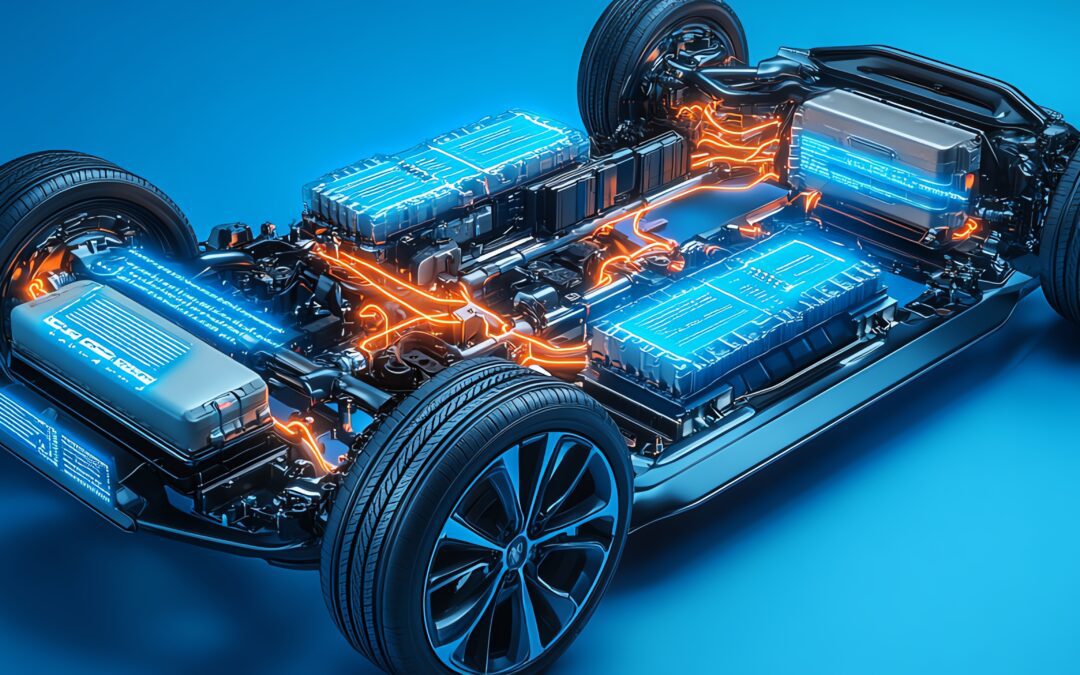Batteries have been around for hundreds of years, powering everything from watches to cars. However, they are currently a major focal point for innovation in the mobility industry.
New chemistries and technologies enable electric and hybrid vehicles to drive, sail, and fly longer on a single charge, reduce production costs, mitigate environmental impact and introduce safety benefits compared to the batteries of the past.
As part of the Road to 2030 initiative, let’s take a closer look at how propulsion batteries are evolving and enabling new opportunities in the Detroit Region mobility ecosystem.
How it works
Batteries, made up of anodes, cathodes and electrolytes, provide the electricity that is then used by motors to propel the vehicle forward or, in aerospace applications, upward. The materials used in batteries, and their components make a massive difference in their performance. The most widely known battery type is a lithium-ion battery, where a compound of lithium is used for electrodes.
The materials used in batteries vary based on how they will be used, as well as the durability, efficiency and weight needed to fulfil their purpose. For example, lithium-ion batteries are high powered, efficient and light for their high-powered performance, making them beneficial for technologies where a lot of power is needed but weight is a consideration.
In hybrid vehicles, where users do not plug the vehicle in, a nickel-metal hydride battery is used. These are not connected to an external source to recharge but instead rely on fuel and the kinetic energy of the vehicle when braking to recharge the battery.
Expansion Potential
With mass interest in hybrid or electric mobility uses, the evolution of battery development allows for technologies to be developed in ways that are increasingly more sustainable and accessible.
Global production of light vehicle propulsion batteries rose nearly sixfold between 2020 and 2024, reaching nearly one terawatt hour per year (a terawatt is an electrical energy storage measurement unit equal to one trillion-watt hours). In 2023, U.S. light vehicle battery demand stood at 12.8% of the global total.
Many vehicle OEMs and suppliers are making investments in new batteries. Likewise, organizations such as the Battery Lab at the University of Michigan, part of the Electric Vehicle Center funded by the State of Michigan’s Labor and Economic Opportunity office, work to share knowledge with others while spearheading the expansion of testing and fabrication of new battery technologies.
While this is just one of the organizations working to develop new battery technologies, the U-M Battery Lab allows for advancements and strengthening of industry through these new battery designs and chemical variants and allows for both academic and industrial stakeholders.
Challenges faced in the evolution of these technologies include:
- High costs associated with the acquisition of materials
- Limited raw materials available for testing and manufacturing
- Finding new ways to manage the recycling and degradation of batteries
Organizations like the U-M Battery Lab are working to limit the impact of these challenges on the development of battery technologies in the industry, ensuring continued growth. Through ongoing technological advancement, batteries are being developed to use smaller amounts of materials that are either expensive or need to be imported from other parts of the world. Improvements in battery cell manufacturing practices have brought down battery costs significantly over the last several years.
U.S. production of propulsion batteries for all mobility sectors is expected to experience fourfold growth by increasing from 1.8 million in 2024 to nearly 6 million in 2030. Over this time frame battery production for light vehicles will be dominant, with 93.6% of total battery production slated for light vehicle applications in 2024 and 95.7% in 2030.
While the light vehicle sector will see the highest volume of propulsion battery applications, their application in several mobility sectors with lower volumes is expected to experience significant growth. By 2030, battery penetration rates are expected to reach 19% for medium and heavy-duty vehicles, 13.1% for aerospace applications, and 8.2% for maritime applications.
Use Cases
Many technologies contribute to the advancement of propulsion batteries in the Detroit Region mobility ecosystem. Some of those organizations include:
- Our Next Energy is working to advance the goal of zero emissions across the world. By innovating battery technology, using new materials and designs, they are improving the range, safety and sustainability of batteries available on the market for use in EV’s. Based in Novi, Mich., Our Next Energy strives to find new materials to use in battery use rather than focusing solely on the raw materials that are currently in short supply.
- American Battery Solutions develops lithium-ion batteries for use in multiple mobility products, including mass transit, marine, and delivery vehicles, as well as smaller vehicles like golf carts. They hope to provide safe, sustainable and cost-effective batteries to organizations across the mobility industry and are wholly committed to a zero-emission present and future.
- Freudenberg E-Power Systems develops and manufactures advanced battery systems for heavy-duty use in over 30 different applications. Freudenberg E-Power Systems strives to find solutions that are sustainable, high performing and adaptable to their client’s needs.
- Fortescue has announced a new facility to produce batteries and other electrification-related components in Detroit. The company has recently revealed that the first batteries built at the facility will be destined for marine applications, providing a clear example of the opportunity for the Detroit region to capitalize on electrification trends to serve non-automotive mobility sectors.
As more mobility stakeholders look to invest in propulsion batteries, GEM and the Detroit Regional Partnership are here for support. In working with organizations across the Detroit Region mobility ecosystem, we aim to foster connections and strong relationships, prepare sites for future use and support local talent in chasing their dreams. We have the knowledge, resources, and relationships to help you succeed regardless of where you are in your business development journey.
Visit gemdetroitregion.com/2030 to learn more.
 Go to DetroitRegionalPartnership.com
Go to DetroitRegionalPartnership.com
